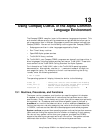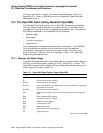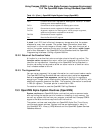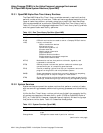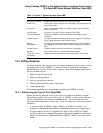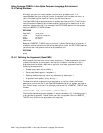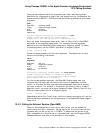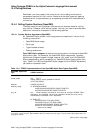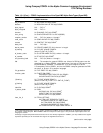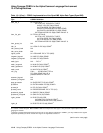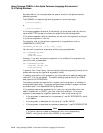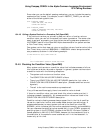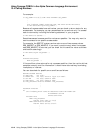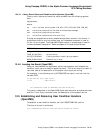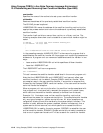
Using Compaq COBOL in the Alpha Common Language Environment
13.4 Calling Routines
Table 13–4 (Cont.) COBOL Implementation of the OpenVMS Alpha Data Types (OpenVMS)
OpenVMS Alpha Data
Type COBOL Definition
ast_procedure 01 AST-PROC PIC 9(9) COMP.
2
boolean 01 BOOLEAN-VALUE PIC 9(9) COMP.
2
byte_signed NA . . . PIC X.
1
byte_unsigned NA . . . PIC X.
1
channel 01 CHANNEL PIC 9(4) COMP.
2
char_string 01 CHAR-STRING PIC X to PIC X(65535).
complex_number NA . . . PIC X(n) where n is length.
1
cond_value 01 COND-VALUE PIC 9(9) COMP.
2
context 01 CONTEXT PIC 9(9) COMP.
2
date_time NA . . . PIC X(8).
1
device_name 01 DEVICE-NAME PIC X(n) where n is length.
d_floating 01 D-FLOAT USAGE COMP-2.
(when /FLOAT=D_FLOAT)
ef_cluster_name 01 CLUSTER-NAME PIC X(n) where n is length.
ef_number 01 EF-NO PIC 9(9) COMP.
2
exit_handler_block NA . . . PIC X(n) where n is length.
1
fab NA . . . Too complex for general COBOL use. Most of a FAB structure can be
described by a lengthy COBOL record description, but such a FAB cannot then
be referenced by a COBOL I-O statement. It is much simpler to do the
I-O completely within COBOL, and let the COBOL compiler generate the FAB
structure, or do the I-O in another language.
file_protection 01 FILE-PROT PIC 9(4) COMP.
2
function_code 01 FUNCTION-CODE.
02 MAJOR-FUNCTION PIC 9(4) COMP.
2
02 SUB-FUNCTION PIC 9(4) COMP.
2
f_floating 01 F-FLOAT USAGE COMP-1.
(when /FLOAT=D_FLOAT or /FLOAT=G_FLOAT)
g_floating 01 G-FLOAT USAGE COMP-2.
(when /FLOAT=G_FLOAT)
identifier 01 ID PIC 9(9) COMP.
2
io_status_block 01 IOSB.
02 COND-VAL PIC 9(4) COMP.
2
02 BYTE-CNT PIC 9(4) COMP.
2
02 DEV-INFO PIC 9(9) COMP.
2
item_list_2 01 ITEM-LIST-TWO.
02 ITEM-LIST OCCURS n TIMES.
04 COMP-LENGTH PIC S9(4) COMP.
04 ITEM-CODE PIC S9(4) COMP.
04 COMP-ADDRESS PIC S9(9) COMP.
02 TERMINATOR PIC S9(9) COMP VALUE 0.
1
Most OpenVMS Alpha data types not directly supported in COBOL can be represented as an alphanumeric data item
of a certain number of bytes. While COBOL does not interpret the data type, it may be used to pass objects from one
language to another.
2
Although unsigned computational data structures are not directly supported in COBOL, you may substitute the signed
equivalent provided you do not exceed the range of the signed data structure.
(continued on next page)
Using Compaq COBOL in the Alpha Common Language Environment 13–9



